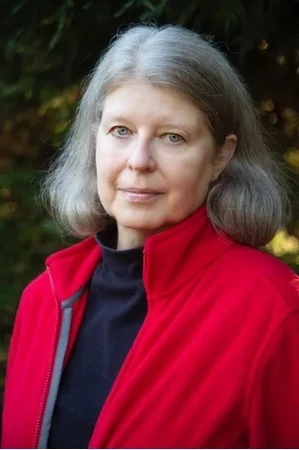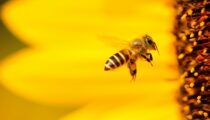Seems you were born closer to an edge than the…

In Conversation: Patricia L. Hudson
When she was writing Traces, her debut historical novel about Rebecca Boone, Patricia L. Hudson had a goal: to bridge the distance between present and past. “My goal…was to make readers feel immersed in these women’s thoughts and feelings, so that you felt as if you were moving through their eighteenth-century world right alongside them,” she explains.
Reading the novel, it quickly becomes clear that Hudson more than succeeded. With great skill, she manages to balance deep character interiority with compelling action that propels the narrative forward—quite the feat for a first-time novelist.
Hudson had long wanted to write a novel about Boone. A longtime journalist whose work has graced the pages of magazines including Southern Living and Country Living, her writing often centered on history: preservation, historic sites and approaching the past with complexity. All the while, her thoughts often turned to Boone, whose story has been largely subsumed by legends surrounding her outsize husband Daniel.
In compelling, lyrical prose, Hudson restores agency to Boone, writing her life with an historian’s eye for narrative and detail, and a novelist’s instinct for characterization and interiority. She recently spoke with Appalachian Review editor Jason Kyle Howard about how she approached Traces, the erasure of women in historical narratives and how she dealt with the Boones’ role in colonialism and Manifest Destiny.
■■■
JASON KYLE HOWARD: As someone who loves history and has grown fascinated with and attached to various historical figures, I’m wondering how you first became interested in Rebecca Boone.
PATRICIA L. HUDSON: In 1996, I happened upon Yale historian John Mack Faragher’s biography of Daniel Boone. I took it home, and though Daniel was interesting, what really fascinated me were the glimpses Faragher provided of the Boone women. I wanted to know more about them, and that led to years of research, gathering the traces of them that remained in the historical record.
JKH: Traces is a remarkable exercise in introspection; you put us fully in the minds of Rebecca, Jemima, and Susannah Boone. Yet it also has some exciting action sequences. I’m thinking here of the enthralling opening. What are the pleasures and challenges of writing both internal thought and action?
PLH: It’s a bit like walking a tightrope—it’s crucial to keep both elements balanced. Action provides momentum and keeps the story moving forward, but without sufficient interiority, characters don’t come alive for your readers. Of course, the opposite is true, as well. Too much interiority can slow the story to a crawl. My goal for Traces was to make readers feel immersed in these women’s thoughts and feelings, so that you felt as if you were moving through their eighteenth-century world right alongside them.
JKH: The historical details in this book are so rich. How did you accomplish the fine balance it takes to make it all accurate yet not putting too much research on the page?
PLH: My first career was as a university reference librarian, and my second was as a journalist, so research is something I enjoy. It’s easy for me to get caught up in tracking down some obscure tidbit of information because my library degree trained me to keep searching until I found an answer. As a novelist, I had to continually remind myself to ignore the things that didn’t specifically serve the novel. The image that comes to mind when I think about my research process is a layer cake. I used research to form the base layer—gathering and laying out all the known historical facts about Rebecca, Susannah and Jemima.
Once I knew where each of the three women would have been, geographically, at each point in their lives, as well as who they were interacting with at the time, I built story arcs for each of them, and only after that did I go back and add another layer of research—sort of like the frosting—putting in all the little details that help readers feel as if they’ve actually stepped back in time. At this final stage I went scene by scene to gauge whether my research was overpowering the story—assessing what needed to be cut, or in some cases, where details needed to be added. Of course, the process is a bit messier than I’ve just described, but a layer cake is a pretty serviceable analogy for how I handle research—it’s the foundation and the frosting.
JKH: A major theme of the novel is reclaiming women’s stories in history, which are often erased, dismissed, overlooked or forgotten. What were your major sources of documentation for the lives of the Boone women?
PLH: About that erasure—my parents took me to Colonial Williamsburg when I was eight, and though I was fascinated by the movie at the visitor’s center that depicted the events that led up to the American Revolution, the women were barely visible; mostly they just waved goodbye to the men who went off to do all the daring deeds. So even at that young age, I recognized that the women’s stories were missing.
Later, as a college history major, I became even more aware of how our country’s primary historical records preserve History, not Herstory. For the most part, the women we know even a small bit about appear in the records in relation to a man—be that father, brother or husband. It’s too late to recover most of these long forgotten women’s stories, but writers of historical fiction can write at least some of the women back into history by gleaning what they can from the existing records, then adding both imagination and intuition to render their stories as realistically as possible.
Daniel became famous at the age of fifty when a land speculator named John Filson published the frontiersman’s stories. Filson didn’t even bother to record any of the Boone women’s names. Most of the information we have about them was collected in the mid-nineteenth century by a man named Lyman Draper. He was obsessed with the pioneer generation, and wound up interviewing the few pioneers who were still alive at that time, as well as their children and grandchildren. His collection, which is housed at the Wisconsin Historical Society, is an indispensible resource for our knowledge of the frontier period. I did most of my research using the Draper Manuscripts, which were available on microfilm at the East Tennessee History Center. I also used both Faragher’s biography, and a more recent biography of Boone by Robert Morgan. I consider Morgan’s biography to be the best one available, because he grew up in western North Carolina and brings a poet’s eye to the telling, as well as a bone-deep understanding of Appalachia.
JKH: Your novel gives us a much more critical eye on Daniel Boone than previous books have done, yet he is also not a villainous character. Talk about that decision.
PLH: When I first started my research, I really didn’t want to like Daniel. Seriously, he left Rebecca on her own to farm and raise a cabin full of children; she birthed ten children, and the family adopted eight others who’d been orphaned. Despite the unspeakable workload such an enormous family created, Daniel felt entitled to disappear into the wilderness, sometimes for years at a time. He justified it by saying the fur trade was how he supported the family, and that’s true up to a point, but it’s pretty clear that many of his excursions were simply because of his love of wilderness. He was an explorer at heart.
Much of the time I wanted to grab Daniel by the shoulders and shake some sense into him for Rebecca’s sake, but I also, rather reluctantly, found him to be extremely likable. He was, by all accounts, a kind man. He had a deep respect for the Native Americans, which was highly unusual for that time period. He managed to maintain both Cherokee and Shawnee friendships throughout his life. He was also endlessly resilient and inclined to make the best of whatever situation he found himself in. In his old age, he was the sort of grandfather who bounced the babies on his knee and told jokes to the older children. I wound up admiring him in spite of myself.
JKH: Much of Daniel Boone’s story is either rooted in or connected to ideas and actions that we now view much more critically—colonialism, Manifest Destiny, the removal of Native peoples, etc. How did you reckon with that in approaching this novel? Did it add another layer of difficulty in writing the book?
PLH: Telling this story definitely presented challenges. The United States is only now beginning to seriously confront the ugliest parts of our history. While I believe it’s long past due, it did create some difficulties for Traces. One of the first things my agent said when she saw the manuscript was, “You’ll have to find sensitivity readers.” My search for a Shawnee sensitivity reader is a saga all by itself.
We recognize now that the “wilderness” wasn’t just empty space—it was home to many different native peoples who fought hard to keep it. As the settlers pushed westward, the idea of Manifest Destiny was woven into our country’s birth story in an effort to absolve what was, in reality, a slow-rolling genocide.
While Traces is told through the eyes of three eighteenth-century white women, I took every possible opportunity within the novel to depict the Native American side of things. My research showed me that Jemima, like her father, didn’t harbor ill will towards the Native Americans in spite of being kidnapped by them at one point in her life. I suspect when the women got the chance to know the people their own culture viewed as “other,” they recognized that human beings of every race are alike, a complex mixture of both good and bad traits.
JKH: The process of fictionalizing historical figures is interesting, but it comes with some particular challenges. What are they?
PLH: One of the challenges I set for myself was to follow the historical record as closely as possible. What interested me was putting these women in the places and situations they actually experienced, and then doing my best to discern what they might have been thinking and feeling.
None of the three women were literate, so their voices have been lost. All that remains are the things others said about them, not what they might have said about themselves. Sticking as closely as possible to the way the actual events unfolded was my way of trying to honor the lives these women actually led.
That said, as a novelist, I occasionally had to shift the timing of an event, or combine several occurrences into a single scene to keep the novel from sprawling too much. For example, an incident I recount about Jemima at the Cumberland River occurred the way I depict it, but it actually happened a couple years later. Because that event offered a window into Jemima’s character, I needed to include it, but because I wasn’t going to show the later journey along Boone’s Trace, it was necessary to move it, time-wise.
When an historical novelist tinkers with history, I believe they should be able to articulate why any changes they’ve made were necessary.
JKH: One of the most interesting aspects of the Boone story is the way Rebecca was accused of having had an affair with her husband’s brother, and you do a beautiful job of writing about that situation with complexity. The historical record is sparse on that relationship, but there were certainly rumors and gossip. Did you have to rely more on your own imagination for that subplot?
PLH: Every biography of Daniel highlights the rumors, so this story of adultery has been the main impression many readers have of Rebecca. I wanted people to know that all three of the Boone women were so much more than the rumors that have followed them down to the present. I researched the rumors as thoroughly as possible, and I while I don’t want to spoil the novel by revealing whether I decided the rumors were true or not, it’s clear the women lived with whispers and innuendo for most of their lives.
JKH: Did you visit any of the real locations, such as Fort Boonesborough, while researching the novel? If so, how did that change your perspective?
PLH: I felt it was critical to visit all the locations connected to the Boones, and that task was made a great deal easier by a wonderful guidebook by North Carolina author, Randell Jones, called In the Footsteps of Daniel Boone. It led me to so many sites, not just the famous ones like Boonesborough, but also house sites, many of which don’t have historical markers. Traveling the back roads in the areas associated with the Boones, gave me a good idea of the terrain and geographical landmarks they would have known. There were a lot of locations all over Appalachia to visit because the family was perpetually on the move.
Standing beside the Kentucky River, on the grassy plain that was the original site of Fort Boonesborough, was invaluable for writing about the various battles that took place there. Although the terrain has changed to a degree, the ridgeline known as Hackberry Ridge remains, as do the bluffs on the far side of the river. It’s haunting to stand on that patch of ground and think about the events that occurred there
In addition to Fort Boonesborough, there are a number of other outstanding living history sites that depict frontier life, such as Martin’s Station in southwest Virginia, which was the final outpost of “civilization” before travellers passed through Cumberland Gap. The reenactors at Martin’s Station, as well as several other living history sites, patiently answered my copious questions about daily life on the frontier.
JKH: What did you find to be the most interesting aspect of Rebecca Boone’s life?
PLH: I think the fact that she managed, in the face of unimaginable hardships, to grow as a person and gain
at least some level of agency over her own life. I came to that conclusion by comparing two descriptions of her that miraculously have survived. The earliest description of Rebecca was from a journal entry made by a Moravian minister who visited the Boone cabin in North Carolina. “She is by nature a quiet soul, and of few words…” he wrote. “She told me of her trouble, and of the frequent distress and fear in her heart.” Daniel wasn’t yet famous, so this missionary viewed Rebecca as just another backcountry housewife.
Another vignette of Rebecca that has survived tells us that, years later, she was brave enough to shame an entire fort of men who she deemed were paying insufficient attention to protecting the women and children. Those two views of her, one uncertain and fearful, the other courageous and decisive, shaped my portrayal of her.
JKH: What’s the best thing you learned about yourself—as a person and/or as a writer—while writing this novel?
PLH: This lengthy journey, from original idea to actually holding the book in my hand, taught me how to persevere through the sort of self-doubt that plagues most writers. I proved to myself that a long-time journalist could learn the craft of fiction, and I discovered that networking with other writers is critical when pursuing one’s dream of publication. Most of all, I’m proud to have helped Rebecca and her girls step out from behind Daniel’s shadow. ■


